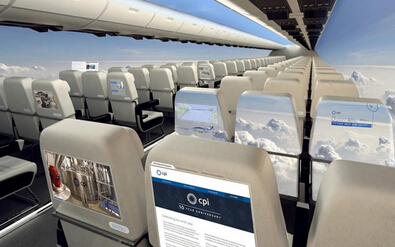Imagine being on a flight where, in place of windows, screens lining the cabin project images of the sky outside. New technology that could help reduce the weight of an aircraft could soon see windowless planes take to the air.
想象一下,你坐在一架飛機上,原本舷窗的位置,現(xiàn)在卻嵌著一排屏幕,屏幕上顯示的是窗外天空的景色。一種用來減輕飛機重量的新技術,或許將很快讓這種“無窗飛機”成為現(xiàn)實。

Plastic display screens for use in aircraft cabins are one of several applications of printable electronics that are being developed at the Centre for Process Innovation in Sedgefield in northeast England, part of the government’s network of technology centres known as “catapults”.
位于英國東北部塞奇菲爾德的工藝流程創(chuàng)新中心(Centre of Process Innovation,簡稱CPI)正在研發(fā)數(shù)種基于“印刷電子”技術的應用,其中就包括用在飛機機艙里的塑料顯示屏。這一中心是英國政府牽頭的、由多個研發(fā)中心組成的被稱為“彈射器”網(wǎng)絡的一部分。
By using conductive inks, printed electronics – technology that has long promised to enliven products from perfume bottles to food packaging – can incorporate electrical circuits in cardboard and plastic for just a few pence per unit. In pharmaceuticals, smart packaging could tell a patient when to take their medication, for example.
通過使用導電墨水,印刷電子技術能將電路集成到紙板和塑料上,每個部件所需成本只要幾便士。人們一直以來都認為這種技術能讓從香水瓶到食品包裝袋的各種產(chǎn)品“活”起來。比如,在制藥領域,智能化包裝能夠告訴患者何時吃藥。
But it is the technology’s potential to help aircraft manufacturers create a windowless plane that is causing most excitement at the CPI for now. By replacing windows with an interactive plastic display screen, the weight of the aircraft would be reduced, helping to lower fuel costs.
然而目前在CPI,最讓人興奮的是,這種技術有可能幫助飛機制造商制造一種無窗飛機。用互動式塑料顯示屏代替窗戶,能減少飛機重量,從而有助于降低燃油成本。
“Getting weight out of a plane is a key [goal] for the industry,” says Tom Taylor, who is part of the management team at CPI.
CPI管理團隊成員湯姆•泰勒(Tom Taylor)表示:“對航空業(yè)來說,減輕飛機重量是一個關鍵(目標)。”
While the windowless plane is not a new concept – freight aircraft and military jets tend not to have windows – commercial aircraft manufacturers have put off the idea until now because of concerns it would be unpopular with passengers.
盡管無窗飛機并不是新概念——貨運飛機和軍用飛機就傾向于不要窗戶,但商用飛機制造商卻一直沒有接納這個概念,因為擔心不受乘客歡迎。
One US aerospace company has announced plans, though. This year Spike Aerospace said it would include a windowless cabin in its Spike S-512 Supersonic Jet, which is due to launch in 2018.
不過,有一家名為Spike Aerospace的美國航空航天公司今年表示,其2018年將會推出的Spike S-512超音速客機,就將配備無窗式機艙。
Vik Kachoria, president of Spike Aerospace, believes the benefits of what he calls the “multiplex digital cabin” will help win over passengers. “They will soon be able to experience a wonderful panoramic view of the outside world,” he says.
Spike Aerospace首席執(zhí)行官維克•凱喬里亞(Vik Kachoria)相信,他所謂的“多重數(shù)字化機艙”會因為好處眾多而贏得乘客。他表示:“他們很快就能體驗到對艙外世界的絕佳全景式觀感。”
However, he says the company plans to include several windows for emergency purposes, which passengers will be able to use for a “quick look” outside.
不過,他也表示該公司計劃在機艙上加上幾個用于緊急狀況的窗戶,乘客能用這些窗戶“快速掃一眼”外部世界。












